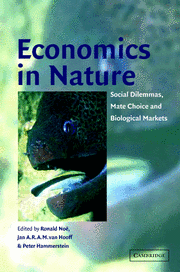Part II - Biological markets
Published online by Cambridge University Press: 04 August 2010
Summary
Various models have been proposed to explain how patterns of cooperative (between conspecifics) and mutualistic (between different species) interaction can arise and can be maintained. Game theoretical approaches, which began with the application of the Prisoners’ Dilemma paradigm, proved very stimulating, but it has become clear that they fall short in accommodating the complexities of the majority of real-life interactions. Various assumptions and implications of these models are not realistic. Thus cooperative and mutualistic interactions do not often occur in dyadic isolation, but mostly take place in a setting where there are many potential players. This implies that partner choice should be an essential element in models of cooperation. Moreover, the ratio of supply and demand for the commodities that the different parties seek to acquire may vary. Depending on this ratio, there may be competition between potential ‘buyers’ and ‘sellers’. Last but not least, there can be communication between the parties, leading to a process of bartering. These are characteristics which we normally associate with a ‘market’.
Ronald Noë was one of the first to realise the limitations of the game theoretic models which were current when he conducted his studies on coalition formation in savannah baboons. In the first chapter of Part II he reviews the different models which have been proposed and argues that a market approach offers a most appropriate perspective for understanding systems of cooperative and mutualistic interaction.
In the following chapters both theoretical considerations and supportive empirical evidence are presented to show that a market model offers the appropriate framework for studying such exchange systems.
- Type
- Chapter
- Information
- Economics in NatureSocial Dilemmas, Mate Choice and Biological Markets, pp. 91 - 92Publisher: Cambridge University PressPrint publication year: 2001
- 1
- Cited by



